UMass Extension's Landscape Message is an educational newsletter intended to inform and guide Massachusetts land care professionals in the management of our collective landscape. Detailed reports from scouts and Extension specialists on growing conditions, pest activity, and cultural practices for the management of woody ornamentals, trees, and turf are regular features. The following issue has been updated to provide timely management information and the latest regional news and environmental data.
Thanks for your continuing interest! We are now in the monthly interval for this season, and the next and final message for 2023 will be posted on November 17. To receive immediate notification when the next Landscape Message update is posted, be sure to join our e-mail list
To read individual sections of the message, click on the section headings below to expand the content:
Scouting Information by Region
Environmental Data
The following data was collected on or about October 11, 2023. Total accumulated growing degree days (GDD) represent the heating units above a 50ºF baseline temperature collected via regional NEWA stations (http://newa.cornell.edu) for the 2023 calendar year. This information is intended for use as a guide for monitoring the developmental stages of pests in your location and planning management strategies accordingly.
|
MA Region/Location |
2023 Growing Degree Days |
Soil Temp |
Precipitation |
Time/Date of Readings |
||
| Gain since last report |
2023 total |
Sun |
Shade |
|||
|
CAPE |
203 |
2680 |
62 |
57 |
1.91 |
10/11/2023 12:00 PM |
|
SOUTHEAST |
203 |
2739 |
69 |
58 |
4.80 |
10/11/2023 12:00 PM |
|
NORTH SHORE |
161 |
2487 |
54 |
53 |
0.64 |
10/11/2023 10:00 PM |
|
EAST |
197 |
2850 |
61 |
56 |
1.24 |
10/11/2023 4:00 PM |
|
METRO |
169 |
2616 |
52 |
51 |
1.28 |
10/11/2023 6:00 AM |
|
CENTRAL |
165 |
2685 |
58 |
55 |
3.64 |
10/12/2023 10:45 AM |
|
PIONEER VALLEY |
186 |
2762 |
58 |
56 |
5.70” |
10/13/2023 9:00 AM |
|
BERKSHIRES |
128 |
2269 |
58 |
53 |
3.69 |
10/11/2023 7:30 AM |
|
AVERAGE |
177 |
2636 |
59 |
55 |
2.46 |
- |
|
n/a = information not available |
||||||
US Drought Monitor: No drought areas are currently designated in the state of Massachusetts. State map as of Thursday 10/12: https://droughtmonitor.unl.edu/CurrentMap/StateDroughtMonitor.aspx?MA
Regional Notes
Cape Cod Region (Barnstable)
General Conditions:
The average temperature for the period from Sepember 22 – October 11 was 59°F with a high of 77°F on October 3. and a low of 43°F on October 9. Overall the period has been seasonal with highs primarily in the 60s and lows primarily in the upper 40s to low 60s. October 3-6 was a particularly nice sunny stretch with highs in the 70s. Precipitation during the period totaled just under 2 inches, primarily falling on Saturdays. Soil moisture is adequate to excessive. Soil temperatures have just started to consistently fall below 60°F in the last few days.
Herbaceous plants seen in bloom during the period include asters (Symphyotrichum spp.), goldenrods (Solidago spp.), lily turf (Liriope muscari), Montauk daisy (Nipponanthemum nipponicum), and many ornamental grasses. Woody plants seen in bloom include abelia (Linnaea x grandiflora), bigleaf hydrangea (Hydrangea macrophylla), Franklin tree (Franklinia alatamaha), and witchhazel (Hamamelis virginiana). Fall foliage color is just beginning on some shrubs and trees.
Pests/Problems:
Insects or insect damage observed during the period includes tupelo leaf miner damage on tupelo, box tree moth caterpillar damage on boxwood, turpentine beetle damage to pitch pine, and white grub damage to turf.
Foliar leaf diseases are abundant on many plants at the this time of year and many trees like crabapples, birch, poplar and cherry have been defoliated. Plant disease symptoms or signs observed during the period include aster yellows on echinacea, hollyhock rust on hollyhock, Botryosphaeria on oak, needlecast on conifers, maple anthracnose, tar spot on maple, phytophthora root rot on lavender, and powdery mildew on many species.
Cool season weeds are germinating.
Southeast Region (Dighton)
General Conditions:
The weather over the last four weeks has been cool and pleasant with frequent rain showers despite the threat of tropical storms passing to our east. The highest temperature was 83°F on Wednesday, October 4th. The low was 41°F on Monday, October 9th. The average temperature overall was 58°F. Total rainfall was a generous 4.8 inches. The highest wind velocity was 20 mph on September 26th.
Japanese knotweed, Polygonum cuspidatum, is still flowering. Fall foliage is begining to peak.
Pests/Problems
Powdery mildew and other fungal diseases have been a problem all season due to frequent rains and high humidity. Emerald ash borer has finally worked its way through the local ash population with hardly any survivors. The decaying trees will soon become hazards.
North Shore (Beverly)
General Conditions:
The weather during this three week period was mostly cloudy with overcast skies and very few sunny days. We had seasonable fall temperatures except for a few days that were above average for this time of the year. Daytime temperatures were mostly in the low to high 60s except for a few days in the low 70s. Daytime temperatures of 80 degrees and above were recorded on two days only. Night temperatures ranged from the low 40s to mid-50s. The average daily temperature for this period was 57°F, with the maximum temperature of 81°F recorded on October 3 and the minimum temperature of 40°F recorded on September 27 and October 10. Approximately 0.64 inches of rain were received at Long Hill during this period. Signs of the fall season are starting to show with foliage changing color on some trees such as ash and some maples. Woody plants seen in bloom include: Franklin tree (Franklinia alatamaha), common witchhazel (Hamamelis virginiana), daphne (Daphne spp.), and white bush clover (Lespedeza thunbergii ‘White Fountain’). Herbaceous plants seen in bloom include: garden phlox (Phlox paniculata), Japanese anemone (Anemone x hybrida), hardy begonia (Begonia grandis), cranesbill (Geranium spp.), autumn crocus (Colchicum autumnale), and turtlehead (Chelone glabra and Chelone lyonii).
Pests/Problems:
Black blister beetles were observed on some plants. Also observed were caterpillars of giant leopard moths. Powdery mildew continues to be seen on some lilacs, beebalm (Monarda), and garden phlox. Mosquito activity will continue to decline as we get into the lower fall temperatures, but ticks will continue to be active whenever temperatures are above freezing. Remember to protect yourself with repellent when working outdoors especially at dawn and dusk.
East (Boston)
General Conditions:
Fall began September 23rd with the autumnal equinox. Total precipitation for September was 5.2 inches. The average daytime temperature over the past three weeks was 68°F with overnight lows averaging 52°F with a low of 42°F on October 10th. October began warm and dry. We recorded no precipitation from the 1st through the 6th, with daytime temperatures averaging 75°F and a high of 83°F on the 3rd. We have received 0.15 inches of precipitation thus far in October. Ornamental fruit is adding color to the landscape; Callicarpa dichotoma (beautyberry), Cornus kousa (Kousa dogwood), Crataegus spp. (hawthorn), Ilex verticillata (winterberry), and Malus spp. (crabapple).
Pests/Problems:
Early leaf drop, due to foliar disease, has been observed on; Acer spp. (maple), Amelanchier spp. (shadbush), Cornus spp. (dogwood), and Prunus spp. (cherry), with minimal fall color. Many perennials are struggling to rebloom with visible signs of fungal disease. The foliage of Convallaria majalis (lily of the valley), Hosta spp. (hosta) and Polygonatum spp. (Solomon’s seal) continues to be devoured by snails and slugs.
Metro West (Acton)
General Conditions:
Fall arrived on the 23rd of September and signs of this season are evident with foliage color change, shortened days, and for most days, cooler temperatures. However one might have thought that summer was still here during the first week in October with temperatures in the 70s and low 80s. A high of 83°F was recorded on the 4th. September’s average monthly rainfall is 3.77” and a total of 4.62” was recorded for the month. This makes the third month in a row where precipitation exceeded its monthly average. October’s average monthly rainfall is 4.32” and 0.3” has been recorded for the month so far. Plants are heavy with fruit, seed, pomes, and nuts and are providing some additional interest in the landscape including on Callicarpa dichotoma (beautyberry), Catalpa spp., Carya spp. (hickory), Convallaria majalis (lily of the valley), Cornus spp. (dogwood), Crataegus spp. (hawthorn), Ilex verticilata (winterberry), Juglans spp. (walnut), Malus spp. (apple and crabapple), Rosa spp. (rose), Quercus spp. (oak), Sorbus spp. (mountain ash), and Viburnum spp.
Pests/Problems:
Not that this is necessarily a problem as the growing season winds down and we enter late fall and winter, but the weekend is approaching and rain is in the forecast once again. According to my records, some amount of precipitation has been recorded on the past 7 weekends.
Central Region (Boylston)
General Conditions:
Weather for this reporting period has been typical for the beginning of fall. Temperatures ranged from 40°F to 83°F, with periods of rain scattered throughout the last few weeks. The rainfall has kept soils waterlogged and dampened weekend gardening activities since it seems to rain every Saturday. The largest rain event was September 29 when we saw more than two inches of precipitation. Fall color is muted this season, with many trees and shrubs already dropping foliage, ahead of schedule and without much of a display. We still have yet to experience a frost, a little later than normal for our region. One interesting mycotroph was observed blooming this period, Hypopitys lanuginosa (hairy pine-sap), which is normally found growing in association with oak trees. Mycotrophs derive their nutrients through a relationship with mycorrhizal fungi, as they lack chlorophyll for photosynthesis.
Pests/Problems:
Foliar diseases are abundant thanks to the wet weather. Powdery mildew on beebalm, phlox, and other perennials is widespread. Early leaf drop likely owing to excessive rain this season has impacted many trees. Notably, red maple (Acer rubrum) and hop hornbeam (Ostrya virginiana) have dropped most of their leaves by now. Beech leaf disease is widespread throughout the region and symptoms are quite obvious on affected trees. Slugs are quite active.
Pioneer Valley (Amherst)
General Conditions:
In recent days, seasonal temperatures have descended across the Pioneer Valley and with the rapidly decreasing daylight, it’s really feeling like autumn now. With the blazing heat in early September and persistent wet weather, that fall feeling was slow to build this year. The first half of October ranged from muggy and wet to pleasant and sunny. Low temperatures in the lower 40s have occurred in recent days, but we’ve been nowhere near our first frost. According to the Northeast Regional Climate Center, the average date for the first frost in our region is roughly 10/10–10/15. Three major rainfall events occurred over the past reporting period on 9/23–25, 9/29–30, and 10/7. Accumulations ranged from 3–5” across Franklin and northern Hampshire Counties and 5–7” across southern Hampshire and Hampden Counties. More than half of this rain fell on 9/29–30 when >3” was recorded at the Easthampton gauge. Even during a season with countless heavy rainstorms, the barrage of intense rain on 9/29 stood out. The forecasted rain on 10/14 would make it the fourth consecutive rainy Saturday. As such, soil moisture remains high and supplemental watering needs have been extremely limited in recent weeks. It’s been a good season for transplanting conifers, as many will produce an abundance of new roots in late summer and autumn. Turfgrasses remain lush and the demand for mowing still hasn’t slowed. However, the long-term forecast calls for highs in the 50s and this should at least increase the interval. One of the highlights of the fall foliage season is a mature sugar maple with a blazing orange canopy contrasted against the dark grey trunk. Yet, this year many sugar maples are exhibiting a blotchy yellow-brown color due to a variety of foliar diseases initiated by the heavy rains. Interestingly, many red maples have been shining brightly, providing some of the best autumn color so far. While red maples are susceptible to the same foliar disease fungi as sugar maple, many trees have proved more resistant. According to the most recent USFS forest inventory and analysis, red maple is the most abundant tree in the Commonwealth. Of the ~1.48 billion trees in the Bay State, approximately 300 million (>20%) are red maples (https://www.fs.usda.gov/research/treesearch/60977).
Pests/Problems:
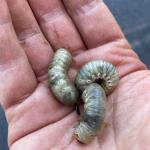
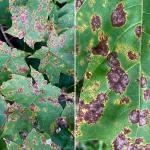 Pest and pathogen activity is slowing as temperatures decline and trees and shrubs begin to enter dormancy. The abundant rain and high humidity provided ideal conditions for many anthracnose, foliar disease, needle blight, and twig/branch cankering pathogens this season. However, the rain was also beneficial for many trees and shrubs, allowing them to allocate resources to defense against various diseases. Continue to prune and discard blighted twigs and branches prior to the dormant season. Reducing inoculum in the canopy can lessen disease severity next growing season. Stink bugs (Halyomorpha halys) are now a frequent sight on window screens and inside homes and buildings. Mosquito populations are still high, but the cooler temperatures and low humidity have suppressed the biting hordes over the past week. Mature green June beetle (Cotinis nitida) larvae can be encountered in turfgrass, vegetable gardens and ornamental beds. Various animals and even birds prey upon these enormous grubs, keeping populations under control. In certain settings, mowing or collecting discarded foliage can reduce foliar disease inoculum that will initiate new infections in the spring. However, some pathogens are so widespread that little can be done to eliminate the development of infections. While mowing maple and birch leaves into lawns can provide beneficial nutrients, the thick and waxy leaves of red and black oak will not soon decompose.
Pest and pathogen activity is slowing as temperatures decline and trees and shrubs begin to enter dormancy. The abundant rain and high humidity provided ideal conditions for many anthracnose, foliar disease, needle blight, and twig/branch cankering pathogens this season. However, the rain was also beneficial for many trees and shrubs, allowing them to allocate resources to defense against various diseases. Continue to prune and discard blighted twigs and branches prior to the dormant season. Reducing inoculum in the canopy can lessen disease severity next growing season. Stink bugs (Halyomorpha halys) are now a frequent sight on window screens and inside homes and buildings. Mosquito populations are still high, but the cooler temperatures and low humidity have suppressed the biting hordes over the past week. Mature green June beetle (Cotinis nitida) larvae can be encountered in turfgrass, vegetable gardens and ornamental beds. Various animals and even birds prey upon these enormous grubs, keeping populations under control. In certain settings, mowing or collecting discarded foliage can reduce foliar disease inoculum that will initiate new infections in the spring. However, some pathogens are so widespread that little can be done to eliminate the development of infections. While mowing maple and birch leaves into lawns can provide beneficial nutrients, the thick and waxy leaves of red and black oak will not soon decompose.
Berkshire Region (West Stockbridge)
General Conditions:
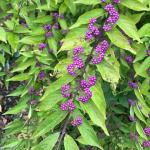 The past three weeks have gone from seasonal to record high temperatures and then down to near freezing temperatures. Record highs were reached on October 4 throughout much of the county. North Adams had the highest at 88°F, while Richmond recorded 84°F and Pittsfield reached 83°F. Those temperatures occurred during a 3-day span of high temperatures and humidity. Since that span, temperatures have rapidly dropped. Low temperatures over the 3-week scouting period occurred October 9th: 35°F in Richmond, 37°F in Pittsfield, and 39°F in North Adams. Periodic rainfall has kept soils moist. Rainfall amounts from September 20th through October 10th were: 3.72 inches in Richmond, 3.69 inches in West Stockbridge, 3.29 inches at North Adams, and 2.80 inches at Pittsfield. Cool temperatures, moist and warm soils have made this an ideal time for planting many trees and shrubs. While managed landscapes remain colorful with many late season blooming herbaceous perennials, there is also the attraction of colorful fruit on certain shrubs, such as purple beautyberry (Callicarpa dichotoma).
The past three weeks have gone from seasonal to record high temperatures and then down to near freezing temperatures. Record highs were reached on October 4 throughout much of the county. North Adams had the highest at 88°F, while Richmond recorded 84°F and Pittsfield reached 83°F. Those temperatures occurred during a 3-day span of high temperatures and humidity. Since that span, temperatures have rapidly dropped. Low temperatures over the 3-week scouting period occurred October 9th: 35°F in Richmond, 37°F in Pittsfield, and 39°F in North Adams. Periodic rainfall has kept soils moist. Rainfall amounts from September 20th through October 10th were: 3.72 inches in Richmond, 3.69 inches in West Stockbridge, 3.29 inches at North Adams, and 2.80 inches at Pittsfield. Cool temperatures, moist and warm soils have made this an ideal time for planting many trees and shrubs. While managed landscapes remain colorful with many late season blooming herbaceous perennials, there is also the attraction of colorful fruit on certain shrubs, such as purple beautyberry (Callicarpa dichotoma).
Pests/Problems:
 Insect problems are minimal now though annoying insects such as mosquitoes are still a nuisance on the warmer days. In landscapes and gardens, the most troublesome critters are the browsers, that is, deer, rabbits, and voles. Given the ongoing frequent rains, slugs and snails remain abundant and damaging. There are numerous complaints about jumping worms (Amynthas spp.). They are not only in abundance in lawns, gardens, and woodlands, but are also very large as they have reached their fully mature stage. As we approach the peak of the fall foliage season, it appears that the normal richness of this colorful time will be diluted as many trees are already denuded or have a thin canopy. Maples seem to be particularly affected. This is due to the preponderance of foliar diseases this year in response to the frequency of rainfall.
Insect problems are minimal now though annoying insects such as mosquitoes are still a nuisance on the warmer days. In landscapes and gardens, the most troublesome critters are the browsers, that is, deer, rabbits, and voles. Given the ongoing frequent rains, slugs and snails remain abundant and damaging. There are numerous complaints about jumping worms (Amynthas spp.). They are not only in abundance in lawns, gardens, and woodlands, but are also very large as they have reached their fully mature stage. As we approach the peak of the fall foliage season, it appears that the normal richness of this colorful time will be diluted as many trees are already denuded or have a thin canopy. Maples seem to be particularly affected. This is due to the preponderance of foliar diseases this year in response to the frequency of rainfall.
Regional Scouting Credits
- CAPE COD REGION - Russell Norton, Horticulture and Agriculture Educator with Cape Cod Cooperative Extension, reporting from Barnstable.
- SOUTHEAST REGION - Brian McMahon, Arborist, reporting from the Dighton area.
- NORTH SHORE REGION - Geoffrey Njue, Green Industry Specialist, UMass Extension, reporting from the Long Hill Reservation, Beverly.
- EAST REGION - Kit Ganshaw & Sue Pfeiffer, Horticulturists reporting from the Boston area.
- METRO WEST REGION – Julie Coop, Forester, Massachusetts Department of Conservation & Recreation, reporting from Acton.
- CENTRAL REGION - Mark Richardson, Director of Horticulture reporting from New England Botanic Garden at Tower Hill, Boylston.
- PIONEER VALLEY REGION - Nick Brazee, Plant Pathologist, UMass Extension Plant Diagnostic Lab, reporting from Amherst.
- BERKSHIRE REGION - Ron Kujawski, Horticultural Consultant, reporting from Great Barrington.
Woody Ornamentals
Diseases
Recent pests, pathogens, or problems of interest seen in the UMass Extension Plant Diagnostic Lab, a select few:
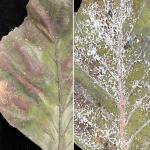 Beech leaf disease (BLD) symptoms, caused by the foliar nematode Litylenchus crenatae ssp. mccannii, are still visible on both American (Fagus grandifolia) and European (F. sylvatica) beech. This year, the woolly beech aphid (Phyllaphis fagi) has been extremely abundant on European beech. This is not considered a serious threat to overall health and in most cases, does not warrant management. Further information on BLD can be found here: https://ag.umass.edu/landscape/fact-sheets/beech-leaf-disease
Beech leaf disease (BLD) symptoms, caused by the foliar nematode Litylenchus crenatae ssp. mccannii, are still visible on both American (Fagus grandifolia) and European (F. sylvatica) beech. This year, the woolly beech aphid (Phyllaphis fagi) has been extremely abundant on European beech. This is not considered a serious threat to overall health and in most cases, does not warrant management. Further information on BLD can be found here: https://ag.umass.edu/landscape/fact-sheets/beech-leaf-disease
Foliar iron (Fe) and/or manganese (Mn) deficiency in the canopy of a red maple (Acer rubrum). The tree is approximately 20-years-old and has been present at the site for 15 years. It experiences full sun in a 7′ diameter mulch circle surrounded by turf and receives drip irrigation. The loam-based soils are characterized as well-drained. This summer, interveinal chlorosis developed in the uppermost portions of the canopy and over time progressed throughout the entire canopy. The primary veins remain green, but the foliage has a pale green to bleached appearance. Both Fe and Mn are micronutrients that are available to plants in soils with a pH <6. While most New England soils have a pH in the range of 5–6, Fe and Mn can be bound in insoluble forms in calcareous or alkaline soils. Both Fe and Mn are critical components of enzyme and energy production.
Phytophthora root rot of Korean fir (Abies koreana ′Horstmann’s Silberlocke′). The tree’s age is unknown but it was 3′ tall when it was purchased in late April this year. It was transplanted into a residential garden with part-sun and was hand-watered during dry periods. Soils were amended with organic matter and are well-drained. The tree flushed new growth and appeared healthy but in August, needle browning and premature shedding developed. The submitted roots had a bluish-brown stain to the vascular tissue with spongy and sloughing bark. Phytophthora was easily detected from the symptomatic root tissue. Secondary twig and small branch cankering was also found. The most likely scenario is that the tree was harboring the infection at the time of planting and the heavy rainfall this summer helped to facilitate disease development. Transplant shock should also be considered as a contributing stress.
Phytophthora bleeding canker on the lower trunk of an Autumn Blaze maple (Acer × freemanii 'Jeffersred'). The tree is approximately 18-years-old and has been present at the current site for 12 years. It experiences full sun and has performed well since installation. The site is characterized by heavy soils that are poorly drained when rainfall is abundant. These conditions are conducive to the development of diseases caused by Phytophthora. This past spring, sunken and bleeding lesions developed on the lower trunk, close to the soil line. The bark was soaked with sap and the underlying sapwood was stained. Basal trunk cankers develop when Phytophthora is splashed from the soil up onto the lower trunk. Despite the canker, the tree has a full canopy. A lower trunk drench with phosphites will hopefully contain the infection and allow the tree to recover.
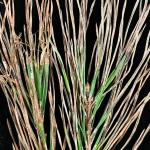
 Needle blight and premature shedding in Scots pine (Pinus sylvestris) grown as Christmas trees. The trees are six to seven-feet-tall and were planted on a standard 5 × 5′ spacing in a semi-shaded area. The farm has well-drained, loam soils but is characterized as dry. In August, needle tip browning developed throughout the canopies of several trees and quickly intensified. After incubation of the symptomatic needles, spore masses produced by Lecanosticta acicola were abundant. Rhizosphaera pinicola, a newly described species, was also present. While common on an array of two- and three-needle pines, R. pinicola does not appear to be an important needle blight pathogen, occurring in conjunction with other more virulent pathogens (e.g. D. sapinea). The trees had received fungicide treatments for needle blight on 5/16 and 5/31, but given the abundant rainfall this season, these treatments were not enough to prevent disease development. There were also symptoms of feeding by the redheaded pine sawfly (Neodiprion lecontei). This native sawfly can often be found attacking Scots pine.
Needle blight and premature shedding in Scots pine (Pinus sylvestris) grown as Christmas trees. The trees are six to seven-feet-tall and were planted on a standard 5 × 5′ spacing in a semi-shaded area. The farm has well-drained, loam soils but is characterized as dry. In August, needle tip browning developed throughout the canopies of several trees and quickly intensified. After incubation of the symptomatic needles, spore masses produced by Lecanosticta acicola were abundant. Rhizosphaera pinicola, a newly described species, was also present. While common on an array of two- and three-needle pines, R. pinicola does not appear to be an important needle blight pathogen, occurring in conjunction with other more virulent pathogens (e.g. D. sapinea). The trees had received fungicide treatments for needle blight on 5/16 and 5/31, but given the abundant rainfall this season, these treatments were not enough to prevent disease development. There were also symptoms of feeding by the redheaded pine sawfly (Neodiprion lecontei). This native sawfly can often be found attacking Scots pine.
Report by Nick Brazee, Plant Pathologist, UMass Extension Plant Diagnostic Lab, UMass Amherst
Insects and Other Arthropods
UMass Extension’s Professional Insect & Mite Management Guide for Woody Plants is Now Available!
Click here to use it now: https://ag.umass.edu/insectmiteguide
This guide is intended for use by professional land managers, including but not limited to: landscapers; arborists; urban and community foresters; tree wardens; local, state, and federal land managers; groundskeepers; and any landscape practitioner who is managing the health of trees and shrubs.
Over 200 potential insect or mite pests of ornamental trees and shrubs are included in this freely available, online, and searchable guide. New insects and insect relatives will be added as the information becomes available.
UMass Extension wants to hear from you! Please complete this brief survey after you use the Professional Insect & Mite Management Guide to provide us with valuable feedback. Your feedback will be used to prioritize updates to this resource now and in the future: https://forms.gle/u2wiLpGijyirkQ9k7.
Interesting Insects Reported Recently:

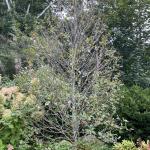 Tupelo Leafminer: Antispila nyssaefoliella is a native insect that occurs on black gum throughout the eastern United States and the southern tip of Ontario. Historically, occasional outbreaks and reports of severe leaf browning caused by the insect have been made (Rose and Lindquist, 1982). Initially, the insect creates a small, linear leaf mine in the host plant leaves. Mines are enlarged over time and become blotch-like. The larvae are legless, cream colored, with gray areas. Fully grown larvae reach up to 5 mm in length. Mature larvae form a case from two oval pieces of leaf cut from the mined area. The larvae then drop to the ground beneath the host plant, within the flattened case. It is here that they pupate. Adults emerge as tiny brown moths. Several generations of the tupelo leafminer may occur per year. The exact timing of this life cycle, or the number of generations per year, are not fully understood for Massachusetts. A sample of tupelo leafminer damage to Nyssa sylvatica ‘Green Gable’ was recently sent to the UMass Plant Diagnostic Lab from Barnstable County, MA. Photos courtesy of Karl Loos and Tawny Simisky.
Tupelo Leafminer: Antispila nyssaefoliella is a native insect that occurs on black gum throughout the eastern United States and the southern tip of Ontario. Historically, occasional outbreaks and reports of severe leaf browning caused by the insect have been made (Rose and Lindquist, 1982). Initially, the insect creates a small, linear leaf mine in the host plant leaves. Mines are enlarged over time and become blotch-like. The larvae are legless, cream colored, with gray areas. Fully grown larvae reach up to 5 mm in length. Mature larvae form a case from two oval pieces of leaf cut from the mined area. The larvae then drop to the ground beneath the host plant, within the flattened case. It is here that they pupate. Adults emerge as tiny brown moths. Several generations of the tupelo leafminer may occur per year. The exact timing of this life cycle, or the number of generations per year, are not fully understood for Massachusetts. A sample of tupelo leafminer damage to Nyssa sylvatica ‘Green Gable’ was recently sent to the UMass Plant Diagnostic Lab from Barnstable County, MA. Photos courtesy of Karl Loos and Tawny Simisky.
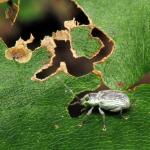 Asiatic Oak Weevil: Cyrtepistomus castaneus is a ¼ to 1/3 inch long weevil that was first introduced into the US in 1933. It now occurs throughout much of the eastern US. Small, legless larvae overwinter near the roots of their host plants, and are in that life stage through the fall, winter, and spring. Pupation occurs as temperatures warm in the spring and adults emerge to feed on newly expanding leaves of oak and chestnut. Adults may emerge as early as May, with abundance peaking in late June and early July. Feeding by the Asiatic oak weevil starts on the margins of their host plant leaves and is sometimes so severe that everything is devoured except the major veins. Adults lay their eggs in the soil starting in July and continue into the fall. This non-native insect has become naturalized and can sometimes be seen feeding on its host plants. Images of the weevil and its feeding were submitted to UMass Extension by Dr. Jennifer Forman Orth, MA Department of Agricultural Resources, from Worcester, MA.
Asiatic Oak Weevil: Cyrtepistomus castaneus is a ¼ to 1/3 inch long weevil that was first introduced into the US in 1933. It now occurs throughout much of the eastern US. Small, legless larvae overwinter near the roots of their host plants, and are in that life stage through the fall, winter, and spring. Pupation occurs as temperatures warm in the spring and adults emerge to feed on newly expanding leaves of oak and chestnut. Adults may emerge as early as May, with abundance peaking in late June and early July. Feeding by the Asiatic oak weevil starts on the margins of their host plant leaves and is sometimes so severe that everything is devoured except the major veins. Adults lay their eggs in the soil starting in July and continue into the fall. This non-native insect has become naturalized and can sometimes be seen feeding on its host plants. Images of the weevil and its feeding were submitted to UMass Extension by Dr. Jennifer Forman Orth, MA Department of Agricultural Resources, from Worcester, MA.
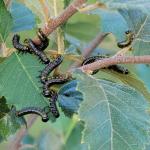
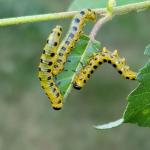 Dusky Birch Sawfly: Croesus latitarsus is a species of sawfly that feeds primarily on birch. Black, gray, Japanese white, paper, red, river, and yellow birch may all be suitable host plants. 1-2 generations occur per year, with the winter spent as a prepupa in a cocoon in the soil. Pupation occurs in the spring, with adult sawflies emerging in May. Eggs are laid and larvae are active roughly between April-May for the 1st generation and again in mid-July to mid-September in the 2nd generation. These sawfly caterpillars feed on the foliage of their hosts. Small trees may be defoliated; however, numbers of this species rarely reach levels where chemical intervention is necessary. Sawflies in this same genus are reportedly parasitized by Compsilura concinnata; however no natural enemies specific to the dusky birch sawfly have been reported. It is recommended that you leave these caterpillars alone if they can be tolerated in your landscape. Not only are they important wildlife themselves, but they may be food for other wildlife such as birds. These beautiful photos of the dusky birch sawfly were taken by Ryan Fawcett, MA Department of Conservation and Recreation, on river birch on 9/18/2023.
Dusky Birch Sawfly: Croesus latitarsus is a species of sawfly that feeds primarily on birch. Black, gray, Japanese white, paper, red, river, and yellow birch may all be suitable host plants. 1-2 generations occur per year, with the winter spent as a prepupa in a cocoon in the soil. Pupation occurs in the spring, with adult sawflies emerging in May. Eggs are laid and larvae are active roughly between April-May for the 1st generation and again in mid-July to mid-September in the 2nd generation. These sawfly caterpillars feed on the foliage of their hosts. Small trees may be defoliated; however, numbers of this species rarely reach levels where chemical intervention is necessary. Sawflies in this same genus are reportedly parasitized by Compsilura concinnata; however no natural enemies specific to the dusky birch sawfly have been reported. It is recommended that you leave these caterpillars alone if they can be tolerated in your landscape. Not only are they important wildlife themselves, but they may be food for other wildlife such as birds. These beautiful photos of the dusky birch sawfly were taken by Ryan Fawcett, MA Department of Conservation and Recreation, on river birch on 9/18/2023.
Current Nuisance Problems of Note:
- Deer Tick/Blacklegged Tick: Ixodes scapularis adults are active all winter and spring, as they typically are from October through May, and “quest” or search for hosts at any point when daytime temperatures are above freezing. Engorged females survive the winter and lay 1,500+ eggs in the forest leaf litter beginning around Memorial Day (late May). For images of all deer tick life stages, along with an outline of the diseases they carry, visit: https://www.capecod.gov/departments/cooperative-extension/programs/ticks-bugs/ or https://web.uri.edu/tickencounter/species/blacklegged-tick/.
Anyone working in the yard and garden should be aware that there is the potential to encounter deer ticks. The deer tick or blacklegged tick can transmit Lyme disease, human babesiosis, human anaplasmosis, and other diseases. Preventative activities, such as daily tick checks, wearing appropriate clothing, and permethrin treatments for clothing (according to label instructions) can aid in reducing the risk that a tick will become attached to your body. If a tick cannot attach and feed, it will not transmit disease. For more information about personal protective measures, visit: https://www.capecod.gov/departments/cooperative-extension/programs/ticks-bugs/.
The Center for Agriculture, Food, and the Environment provides a list of potential tick identification and testing resources.
*In the news: UMass Amherst has now been designated as the location for the New England Center of Excellence in Vector-Borne Diseases (NEWVEC). This CDC (Centers for Disease Control and Prevention) funded center will work to reduce the risk of vector-borne diseases spread by ticks, mosquitoes, and other blood-sucking insects or insect relatives in New England. For more information and to contact NEWVEC, visit: https://www.newvec.org/. To contact the center for more information about their Spring 2023 Project ITCH (“Is Tick Control Helping”), visit: https://www.newvec.org/itch .
- Mosquitoes: According to the Massachusetts Bureau of Infectious Disease and Laboratory Science and the Department of Public Health, there are at least 51 different species of mosquito found in Massachusetts. Mosquitoes belong to the Order Diptera (true flies) and the Family Culicidae (mosquitoes). As such, they undergo complete metamorphosis, and possess four major life stages: egg, larva, pupa, and adult. Adult mosquitoes are the only stage that flies and many female mosquitoes only live for 2 weeks (although the life cycle and timing will depend upon the species). Only female mosquitoes bite to take a blood meal, and this is so they can make eggs. Mosquitoes need water to lay their eggs in, so they are often found in wet or damp locations and around plants. Different species prefer different habitats. It is possible to be bitten by a mosquito at any time of the day, and again timing depends upon the species. Many are particularly active from just before dusk, through the night, and until dawn. Mosquito bites are not only itchy and annoying, but they can be associated with greater health risks. Certain mosquitoes vector pathogens that cause diseases such as West Nile virus (WNV) and eastern equine encephalitis (EEE).
Click here for more information about mosquitoes in Massachusetts.
EEE and WNV testing and tracking for this season began on June 12, 2023. The Massachusetts Department of Public Health tracks animal cases, human cases, and mosquito positive samples from traps from June through October in Massachusetts. The first West Nile Virus positive mosquito sample was collected on July 6, 2023, in the town of Brookline in Norfolk County, MA. Click here for more information.
As of 10/11/2023, 163 positive WNV mosquito samples have been collected in the state. See the previous link for specific locations.
As of 10/11/2023, 4 human cases of WNV have been reported in Massachusetts.
The first eastern equine encephalitis (EEE) positive mosquito samples for 2023 were detected in Massachusetts as of 9/1/2023: https://www.mass.gov/news/state-public-health-officials-announce-seasons-first-eee-positive-mosquito-samples. As of 10/11/2023, 27 positive EEE mosquito samples have been collected in the state. See the previous link for specific locations.
There are ways to protect yourself against mosquitoes, including wearing long-sleeved shirts and long pants, keeping mosquitoes outside by using tight-fitting window and door screens, and using insect repellents as directed. Products containing the active ingredients DEET, permethrin, IR3535, picaridin, and oil of lemon eucalyptus provide protection against mosquitoes. Be aware that not all of these can be safely used on young children. Read and follow all label instructions for safety and proper use.
Click here for more information about mosquito repellents.
- Wasps/Hornets: Many wasps are predators of other arthropods, including pest insects such as certain caterpillars that feed on trees and shrubs. Adult wasps hunt prey and bring it back to their nest where young are being reared, as food for the immature wasps. A common such example are the paper wasps (Polistes spp.) who rear their young on chewed up insects. They may be seen searching plants for caterpillars and other soft-bodied larvae to feed their young. Paper wasps can sting, and will defend their nests, which are open-celled paper nests that are not covered with a papery “envelope”. These open-celled nests may be seen hanging from eaves or other outdoor building structures. Aerial yellow jackets and hornets create large aerial nests that are covered with a papery shell or “envelope”. Common yellow jacket species include those in the genus Vespula. Dolichovespula maculata is commonly known as the baldfaced hornet, although it is not a true hornet. The European hornet (Vespa crabro) is three times the size of a yellow jacket and may be confused for the northern* giant hornet (Vespa mandarinia). The European hornet is known to Massachusetts, but the northern giant hornet is not. European hornets have black, tear-drop shaped markings on their abdomens, but northern giant hornets do not. If you are concerned that you have found or photographed a northern giant hornet, please report it here: https://massnrc.org/pests/report.aspx. Recent articles in the news have homeowners concerned about a new invasive species of hornet that is closely related to the northern giant hornet. The yellow-legged hornet (Vespa velutina) has been detected in Georgia as of August 2023. The yellow-legged hornet is native to Southeast Asia and smaller than the northern giant hornet. There is concern that the yellow-legged hornet, if allowed to establish in the USA, could pose a threat to honeybee health. More information can be found here: https://agr.georgia.gov/yellow-legged-hornet . If you suspect you’ve seen the yellow-legged hornet in Massachusetts, take a photo and submit a report here: https://massnrc.org/pests/report.aspx .
Paper wasps and aerial yellowjackets overwinter as fertilized females (queens) and a single female produces a new nest annually in the late spring. Queens start new nests, lay eggs, and rear new wasps to assist in colony/nest development.Nests are abandoned at the end of the season. Some people are allergic to stinging insects, so care should be taken around wasp/hornet nests. Unlike the European honeybee (Apis mellifera), wasps and hornets do not have barbed stingers, and therefore can sting repeatedly when defending their nests. It is best to avoid them, and if that cannot be done and assistance is needed to remove them, consult a professional.
*Read more about the common name change for Vespa mandarinia.
Woody ornamental insect and non-insect arthropod pests to consider, a selected few:
Highlighted Invasive Insects & Other Organisms Update:
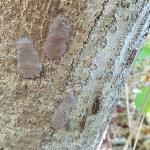 Spotted Lanternfly: (Lycorma delicatula, SLF) is a non-native, invasive insect that feeds on over 103 species of plants, including many trees and shrubs that are important in our landscapes. As of September 2023, the MA Department of Agricultural Resources (MDAR) has announced three additional populations of spotted lanternfly in Massachusetts. This brings the total locations of established populations of spotted lanternfly in Massachusetts to: Fitchburg, Shrewsbury, Worcester, Springfield, Holyoke, Agawam, and Southborough, MA.
Spotted Lanternfly: (Lycorma delicatula, SLF) is a non-native, invasive insect that feeds on over 103 species of plants, including many trees and shrubs that are important in our landscapes. As of September 2023, the MA Department of Agricultural Resources (MDAR) has announced three additional populations of spotted lanternfly in Massachusetts. This brings the total locations of established populations of spotted lanternfly in Massachusetts to: Fitchburg, Shrewsbury, Worcester, Springfield, Holyoke, Agawam, and Southborough, MA.
As a reminder, there is no reason to be preemptively treating for this insect in other areas of Massachusetts. If you suspect you have found spotted lanternfly in additional locations, please report it immediately to MDAR here. If you are living and working in the above listed areas, please be vigilant and continue to report anything suspicious. Additionally, information about managing spotted lanternfly is provided in the Spotted Lanternfly Management Guide for Professionals, below.
For More Information:
From UMass Extension:
Spotted Lanternfly Management Guide for Professionals
*Note that management may only be necessary in areas where this insect has become established in Massachusetts and if high value host plants are at risk. Preemptive management of the spotted lanternfly is not recommended.
Check out the InsectXaminer Episode about spotted lanternfly adults and egg masses!
From the MA Department of Agricultural Resources (MDAR):
Spotted Lanternfly Fact Sheet and Map of Locations in MA
Spotted Lanternfly Management Guide for Homeowners in Infested Areas
*New*: Spotted Lanternfly Look-alikes in MA
*New*: Spotted Lanternfly Egg Mass Look-alikes
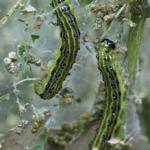
 Box Tree Moth: staff with the Mass. Dept. of Agricultural Resources (MDAR) and the USDA have recently confirmed several instances of boxwood shrubs on Cape Cod that were infested with the invasive pest known as box tree moth (Cydalima perspectalis). The finds have all been in established plantings (2 years old or more). It is unclear how the moths were introduced to the area or how widespread this pest is; USDA is currently working to delimit the infestation.
Box Tree Moth: staff with the Mass. Dept. of Agricultural Resources (MDAR) and the USDA have recently confirmed several instances of boxwood shrubs on Cape Cod that were infested with the invasive pest known as box tree moth (Cydalima perspectalis). The finds have all been in established plantings (2 years old or more). It is unclear how the moths were introduced to the area or how widespread this pest is; USDA is currently working to delimit the infestation.
The main host of box tree moth is boxwoods (Buxus spp.), though in their native range, the moths will also attack burning bush (Euonymus alatus) and a few other uncommon species, if boxwood is not available. The late-stage caterpillars cause significant defoliation and should be detectable now: check boxwoods for greenish brown caterpillars, 1 to 1.5 inches long, with black stripes running from head to tip, black heads, and long hairs scattered along the body. The caterpillars form webbing in the boxwoods to protect themselves, and in a heavy infestation this webbing fills up with visible clumps of frass pellets (waste material).
Box tree moths can cause complete defoliation of boxwoods, eventually killing entire shrubs. We encourage you to review the following fact sheet from the USDA to learn more about this pest, including how to recognize the adult moths, caterpillars, and eggs: Box Tree Moth Pest Alert
If you grow, sell, or install boxwoods, please inspect them for any signs of this pest, and report any finds to https://massnrc.org/pests/report.aspx
More information about box tree moth, including management options, is now available from UMass Extension at: https://ag.umass.edu/landscape/fact-sheets/box-tree-moth.

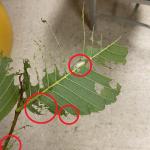
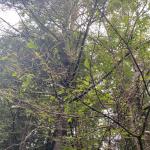 Elm Zigzag Sawfly: (Aproceros leucopoda) is a nonnative insect that originated in eastern Asia (Japan and certain regions of China). It is now invasive in Europe (2003) and North America. The elm zigzag sawfly has been found in Virginia (2021), Maryland, Pennsylvania, North Carolina, New York, and Vermont. In 2023, the elm zigzag sawfly was detected for the first time in a small, forested area of Berkshire and Hampden Counties in Massachusetts: https://www.mass.gov/news/dcr-announces-that-elm-zigzag-sawfly-has-been-confirmed-in-massachusetts. Significant defoliation of elm host plants was seen at the impacted locations. It is currently unclear how widespread the elm zigzag sawfly is in Massachusetts or how the infestation was introduced.
Elm Zigzag Sawfly: (Aproceros leucopoda) is a nonnative insect that originated in eastern Asia (Japan and certain regions of China). It is now invasive in Europe (2003) and North America. The elm zigzag sawfly has been found in Virginia (2021), Maryland, Pennsylvania, North Carolina, New York, and Vermont. In 2023, the elm zigzag sawfly was detected for the first time in a small, forested area of Berkshire and Hampden Counties in Massachusetts: https://www.mass.gov/news/dcr-announces-that-elm-zigzag-sawfly-has-been-confirmed-in-massachusetts. Significant defoliation of elm host plants was seen at the impacted locations. It is currently unclear how widespread the elm zigzag sawfly is in Massachusetts or how the infestation was introduced.
Female elm zigzag sawflies cause a tiny amount of damage to the edges of host plant leaves as they lay their eggs. Tiny scars are formed as a result of female egg laying. Eggs hatch and young sawfly caterpillars (the most destructive life stage of the insect) begin their characteristic zig-zag patterned feeding. These zig-zag shaped notches in the leaf can extend 5-10 mm into the leaf from the edge. Multiple caterpillars can feed on a single leaf. Entire leaves can be completely stripped, leaving only the veins behind. Heavily infested trees can suffer partial or complete defoliation.
If you suspect you have found elm zigzag sawfly in Massachusetts, please report it to Nicole Keleher (Massachusetts Department of Conservation and Recreation, Forest Health Program), Nicole.Keleher@mass.gov, or to the MA Dept. of Agricultural Resources at https://massnrc.org/pests/report.aspx.
More information about the elm zigzag sawfly, including management options, is now available from UMass Extension at: https://ag.umass.edu/landscape/fact-sheets/elm-zigzag-sawfly.
- Southern Pine Beetle: Dendroctonus frontalis has been collected in traps in Massachusetts and other parts of New England in recent years. Historically, the southern pine beetle has been native to the southeastern United States, however its range is moving northward due to warming winters and climate change. The Massachusetts Department of Conservation and Recreation (DCR) Forest Health Program, has announced that they have detected the first pocket of southern pine beetle killed trees (pitch pine, Pinus rigida) in Massachusetts on Nantucket. This is the first observation of this species killing trees in the state. An active infestation of southern pine beetle was found killing trees in July and MA DCR is working with the property owner to determine next steps and potential management options at the site. If you believe you have detected southern pine beetles in trees in Massachusetts, please contact Nicole Keleher, MA DCR Forest Health Director, at: nicole.keleher@mass.gov. More information about southern pine beetle is also available from MA DCR at https://storymaps.arcgis.com/stories/b60f63199fa14805a8b9f7c82447a25b .
- Asian Longhorned Beetle: (Anoplophora glabripennis, ALB) Look for signs of an ALB infestation which include perfectly round exit holes (about the size of a dime), shallow oval or round scars in the bark where a female has chewed an egg site, or sawdust-like frass (excrement) on the ground nearby host trees or caught in between branches. Be advised that other, native insects may create perfectly round exit holes or sawdust-like frass, which can be confused with signs of ALB activity.
Adult Asian longhorned beetles typically begin to emerge from trees by July 1st in Massachusetts. It is important to take photographs of and report any suspicious longhorned beetles to the Asian Longhorned Beetle Eradication Program phone numbers listed below.
The regulated area for Asian longhorned beetle is 110 square miles encompassing Worcester, Shrewsbury, Boylston, West Boylston, and parts of Holden and Auburn. If you believe you have seen damage caused by this insect, such as exit holes or egg sites, on susceptible host trees like maple, please call the Asian Lonbghorned Beetle Eradication Program office in Worcester, MA at 508-852-8090 or toll free at 1-866-702-9938.
Report an Asian longhorned beetle find online or compare it to common insect look-alikes here.
 Emerald Ash Borer: (Agrilus planipennis, EAB) has been detected throughout much of Massachusetts and it was recently detected for the first time in Barnstable County. A map of these locations across the state is provided by the MA Department of Conservation and Recreation at https://storymaps.arcgis.com/stories/b60f63199fa14805a8b9f7c82447a25b.
Emerald Ash Borer: (Agrilus planipennis, EAB) has been detected throughout much of Massachusetts and it was recently detected for the first time in Barnstable County. A map of these locations across the state is provided by the MA Department of Conservation and Recreation at https://storymaps.arcgis.com/stories/b60f63199fa14805a8b9f7c82447a25b.
This wood-boring beetle readily attacks ash (Fraxinus spp.) including white, green, and black ash and has also been found developing in white fringe tree (Chionanthus virginicus) and has been reported in cultivated olive (Olea europaea). Signs of an EAB infested tree may include D-shaped exit holes in the bark (from adult emergence), “blonding” or lighter coloration of the ash bark from woodpecker feeding (chipping away of the bark as they search for larvae beneath), and serpentine galleries visible through splits in the bark, from larval feeding beneath. It is interesting to note that woodpeckers are capable of eating 30-95% of the emerald ash borer larvae found in a single tree (Murphy et al. 2018). Unfortunately, despite high predation rates, EAB populations continue to grow. However, there is hope that biological control efforts will eventually catch up with the emerald ash borer population and preserve some of our native ash tree species for the future.
- Jumping Worms: Amynthas spp. earthworms, collectively referred to as “jumping or crazy or snake” worms, overwinter as eggs in tiny, mustard-seed sized cocoons found in the soil or other substrate (ex. compost). Immature jumping worms hatch from their eggs by approximately mid-to-late May. It may be impossible to see them at first, and it may be more likely that jumping worms are noticed when the first adults begin to appear at the end of May and in June. It is easy to misidentify jumping worms (ex. mistake European earthworms for jumping worms) if only juveniles are found. In August and September, most jumping worms have matured into the adult life stage and identification of infestations is more likely to occur at that time of year.
For More Information, see these UMass Extension Fact Sheets:
Earthworms in Massachusetts – History, Concerns, and Benefits
Jumping/Crazy/Snake Worms – Amynthas spp.
A Summary of the Information Shared at UMass Extension’s Jumping Worm Conference in January 2022
Invasive Jumping Worm Frequently Asked Questions (Over 70 Questions and their Answers)
Tree & Shrub Insect Pests (Native and Invasive):
- Eastern Spruce Gall Adelgid: Adelges abietis prefers to form galls on Norway spruce, but may also be found on black, Colorado blue, Engelmann, red, or white spruce. By late summer, these galls dry out, crack open, and the nearly mature nymphs emerge. Once "on the outside", these nymphs develop into winged females who will lay another crop of eggs coated in white woolly wax, which will hatch into the nymphs who will spend the winter near a terminal twig or dormant bud.
- Fall Home-Invading Insects: Various insects, such as ladybugs, boxelder bugs, seedbugs, and stink bugs will begin to seek overwintering shelters in warm places, such as homes, throughout the next couple of months. While such invaders do not cause any measurable structural damage, they can become a nuisance especially when they are present in large numbers. While the invasion has not yet begun, if you are not willing to share your home with such insects, now should be the time to repair torn window screens, repair gaps around windows and doors, and sure up any other gaps through which they might enter the home.
- Fletcher Scale: Parthenolecanium fletcheri is found on Taxus spp., arborvitae, juniper, and others. Nymphs are preparing to overwinter on host plant needles or twigs.
- Larch Casebearer: Coleophora laricella may be found on European or North American larch (Larix) species. Larvae of this species are preparing to overwinter in a whitish, cigar-shaped case that may look like a dead needle attached to host plant branches or near the base of host plant buds. Caterpillars will resume feeding when temperatures warm next spring.
- Locust Borer: Megacyllene robiniae is native to North America and can be found boring into black locust (Robinia pseudoacacia). Adult beetles may be found on goldenrod now until the first frost. Adults will finish laying eggs on host plant bark, and larvae will tunnel into the tree where they will overwinter.
- Magnolia Scale: Neolecanium cornuparvum nymphs are preparing to overwinter on one and two year old twigs of their host plants. These include cucumber, lily, saucer, and star magnolias.
- Poplar and Willow Borer: Cryptorhynchus lapathi weevils are preparing to overwinter as larvae of various instars in the sapwood of their host plants which includes alder, birch, cottonwood, poplar, and willow.
- Redbanded Leafhopper: Graphocephala coccinea adults are present in the landscape and may be associated with rhododendron until the first killing frost.
- Redheaded Pine Sawfly: Neodiprion lecontei larvae should be finishing their feeding on various ornamental pines and dropping to the leaflitter nearby suitable hosts to overwinter in the prepupal life stage. Pre-pupae are in a ½ inch reddish brown and paper-like cocoon.
- Spruce Spider Mite: Oligonychus ununguis is a cool season mite that may be active on hosts including but not limited to: arborvitae, fir, hemlock, juniper, larch, pine, spruce, and yew until frost.
Concerned that you may have found an invasive insect or suspicious damage caused by one? Need to report a pest sighting? If so, please visit the Massachusetts Introduced Pests Outreach Project.
Reported by Tawny Simisky, Extension Entomologist, UMass Extension Landscape, Nursery, & Urban Forestry Program
Landscape Weeds
Japanese knotweed in most areas in New England is near the end of its flowering period. There is time to treat knotweed as long as the leaves are still green. Applications of glyphosate are the best choice for Japanese knotweed management. For areas near and around water, you will need to use a glyphosate formulation that is labeled for these areas. Since knotweed commonly grows in wet areas or near streams, rivers or wetlands, the management of this invasive plant may invoke 310 CMR 10.00 (the Massachusetts Wetlands Protection Act). 310 CMR 10.00 regulates all activities in the resource areas identified in the act. Before any management attempts are carried out, you should contact the Conservation Commission in the municipality to determine to what extent 310 CMR 10.00 might impact your project. For states other than Massachusetts, you should seek information about that state’s regulation for activities near water. At this point, if the process of working with the local Conservation Commission is not completed or close to completion, you will likely have to more your focus to treating Japanese knotweed next year.
Poison ivy is in fruit and should be treated now. Glyphosate or triclopyr are the best herbicides for poison ivy control. Triclopyr products should be selected over glyphosate in areas where grasses need to be saved. Contact (ScytheTM, RewardTM) or the non-chemical/organic herbicide products will provide “burndown” activity only and will not adequately control poison ivy. REMEMBER, the oil in poison ivy, known as urushiol, is still active in the plant after the plant is dead and can still cause contact dermatitis. Urushiol occurs in all parts of the plant, including the roots.
Many winter annual weeds will be germinating in the next month and a half, so now is the time to mulch landscape beds or areas that are known to have populations of winter annual weeds. Some common landscape winter annual weeds are:
- mouse-ear cress (Arabidopsis thaliana)
- thymeleaf sandwort (Arenaria serpyllifolia)
- downy brome (Bromus tectorum)
- shepherd's-purse (Capsella bursa-pastoris)
- bittercress (Cardamine hirsuta)
- sticky chickweed (Cerastium viscosum)
- horseweed (Conyza canadensis)
- spring whitlowgrass (Draba verna)
- henbit (Lamium amplexicaule)
- red deadnettle (Lamium purpureum)
- field pepperweed (Lepidium campestre)
- Virginia pepperweed (Lepidium virginicum)
- pineappleweed (Matricaria matricariodes)
- annual bluegrass (Poa annua)
- knawel (Scleranthus annuus)
- common chickweed (Stellaria media)
- field pennycress (Thlaspi arvense)
- corn speedwell (Veronica arvensis)
- purslane speedwell (Veronica peregrina)
For information about identification of these weeds, check out UMass Extension's Weed Herbarium: https://extension.umass.edu/weed-herbarium/
Reported by Randy Prostak, Weed Specialist, UMass Extension Landscape, Nursery, & Urban Forestry Program
Additional Resources
Pesticide License Exams - The MA Dept. of Agricultural Resources (MDAR) is now holding exams online. For more information and how to register, go to: https://www.mass.gov/pesticide-examination-and-licensing.
To receive immediate notification when the next Landscape Message update is posted, join our e-mail list or follow us on Facebook.
For a complete listing of landscape, nursery, and urban forestry program upcoming events, see our calendar at https://ag.umass.edu/landscape/upcoming-events.
For commercial growers of greenhouse crops and flowers - Check out UMass Extension's Greenhouse Update website.
For professional turf managers - Check out our Turf Management Updates.
For home gardeners and garden retailers - Check out our home lawn and garden resources.
Diagnostic Services
UMass Laboratory Diagnoses Landscape and Turf Problems - The UMass Extension Plant Diagnostic Lab is available to serve commercial landscape contractors, turf managers, arborists, nurseries and other green industry professionals. It provides woody plant and turf disease analysis, woody plant and turf insect identification, turfgrass identification, weed identification, and offers a report of pest management strategies that are research based, economically sound and environmentally appropriate for the situation. Accurate diagnosis for a turf or landscape problem can often eliminate or reduce the need for pesticide use. For sampling procedures, detailed submission instructions and a list of fees, see the Plant Diagnostic Laboratory web site.
Soil and Plant Nutrient Testing - The University of Massachusetts Soil and Plant Nutrient Testing Laboratory is located on the campus of the University of Massachusetts at Amherst. Testing services are available to all. The lab provides test results and recommendations that lead to the wise and economical use of soils and soil amendments. For more information, including current turn-around times, visit the UMass Soil and Plant Nutrient Testing Laboratory web site. The lab is currently accepting orders for Routine Soil Analysis (including optional Organic Matter, Soluble Salts, and Nitrate testing), Particle Size Analysis, Pre-Sidedress Nitrate (PSNT), Total Sorbed Metals, and Soilless Media (no other types of soil analyses available at this time). Check for current turnaround time. Please plan for the fact that date of receipt in the lab is affected by weekends, holidays, shipping time, and time for UMass Campus Mail to deliver samples to the lab.
Tick Testing - The UMass Center for Agriculture, Food, and the Environment provides a list of potential tick identification and testing options at: https://ag.umass.edu/resources/tick-testing-resources.
Acknowledgements: UMass Extension gratefully acknowledges the support of the following funding sources for the production of the Landscape Message –
- The Massachusetts Nursery and Landscape Association Fund
- The Massachusetts Department of Conservation and Recreation, Award #ISADCR28219926UMA23A
- Stakeholders like you! The Landscape Message is partially supported by educational program user fees.